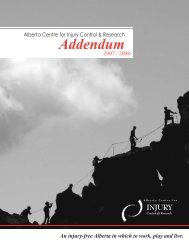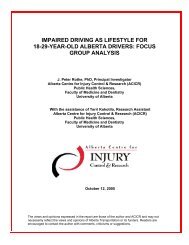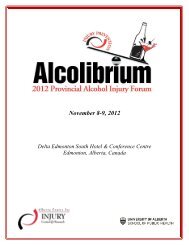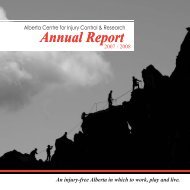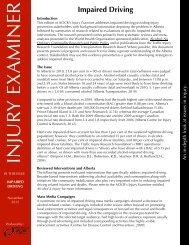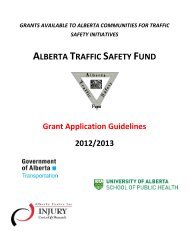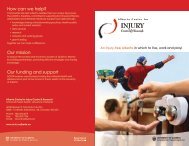Safety Guidelines for Secondary Interschool Athletics in Alberta
Safety Guidelines for Secondary Interschool Athletics in Alberta
Safety Guidelines for Secondary Interschool Athletics in Alberta
You also want an ePaper? Increase the reach of your titles
YUMPU automatically turns print PDFs into web optimized ePapers that Google loves.
APPENDIX W - WATER SAFETY<br />
The follow<strong>in</strong>g describes the Lifesav<strong>in</strong>g Society’s Swim to Survive® Standard. More <strong>in</strong><strong>for</strong>mation about<br />
the program and other water safety considerations (such as lifeguard<strong>in</strong>g) is available at<br />
www.lifesav<strong>in</strong>g.org.<br />
Instructional Considerations:<br />
• Students participat<strong>in</strong>g <strong>in</strong> water activities conducted <strong>in</strong> water deeper than chest height should meet the<br />
Swim to Survive® Standard.<br />
• Students who cannot meet the Swim to Survive® Standard can still participate <strong>in</strong> deep water<br />
activities as long as they are wear<strong>in</strong>g a properly fitted lifejacket or Personal Floatation Device<br />
(PFD).<br />
• Prior to participat<strong>in</strong>g <strong>in</strong> boat<strong>in</strong>g activities, students should demonstrate the three skills <strong>in</strong>volved <strong>in</strong><br />
the Swim to Survive® Standard while wear<strong>in</strong>g a properly fitted life jacket or PFD.<br />
Swim to Survive® Standard:<br />
The Swim to Survive® Standard is a simple, straight<strong>for</strong>ward and focused national standard that def<strong>in</strong>es<br />
the m<strong>in</strong>imum swimm<strong>in</strong>g skills needed to survive an unexpected fall <strong>in</strong>to deep water. The Swim to<br />
Survive® Standard is a sequence of three skills:<br />
Swim to Survive® Standard = ROLL <strong>in</strong>to deep water + TREAD water (1 m<strong>in</strong>.) + SWIM 50m<br />
Task<br />
Essential skill & rationale<br />
Roll <strong>in</strong>to water<br />
M<strong>in</strong>imum safe depth <strong>for</strong><br />
teach<strong>in</strong>g <strong>in</strong> 2.5m or 8 ft. 4<br />
<strong>in</strong>ches.<br />
Tread water <strong>for</strong> 1 m<strong>in</strong>ute<br />
Swim 50 metres<br />
Orient oneself at the surface after an unexpected entry.<br />
A fall <strong>in</strong>to water is distort<strong>in</strong>g and a threat to normal respiration.<br />
Support oneself at the surface.<br />
Canadian waters are generally cold enough year-round to trigger a<br />
gasp<strong>in</strong>g reflex on unexpected immersion. The ability to tread water<br />
allows you to protect your airway while rega<strong>in</strong><strong>in</strong>g control of your<br />
breath<strong>in</strong>g.<br />
Swim to safety.<br />
Lifesav<strong>in</strong>g Society research shows most drown<strong>in</strong>gs occur with<strong>in</strong> 3 to 15<br />
metres of safety (dock, shorel<strong>in</strong>e, pool edge). Because your ability may<br />
be impaired by cold water, cloth<strong>in</strong>g, etc, we use a 50 m distance as a<br />
reasonable standard.<br />
Any method that allows the learner to achieve the standard is acceptable<br />
there is no “right” solution<br />
108<br />
<strong>Safety</strong> <strong>Guidel<strong>in</strong>es</strong> <strong>for</strong> <strong>Secondary</strong> <strong>Interschool</strong> <strong>Athletics</strong> <strong>in</strong> <strong>Alberta</strong> - February 2012



